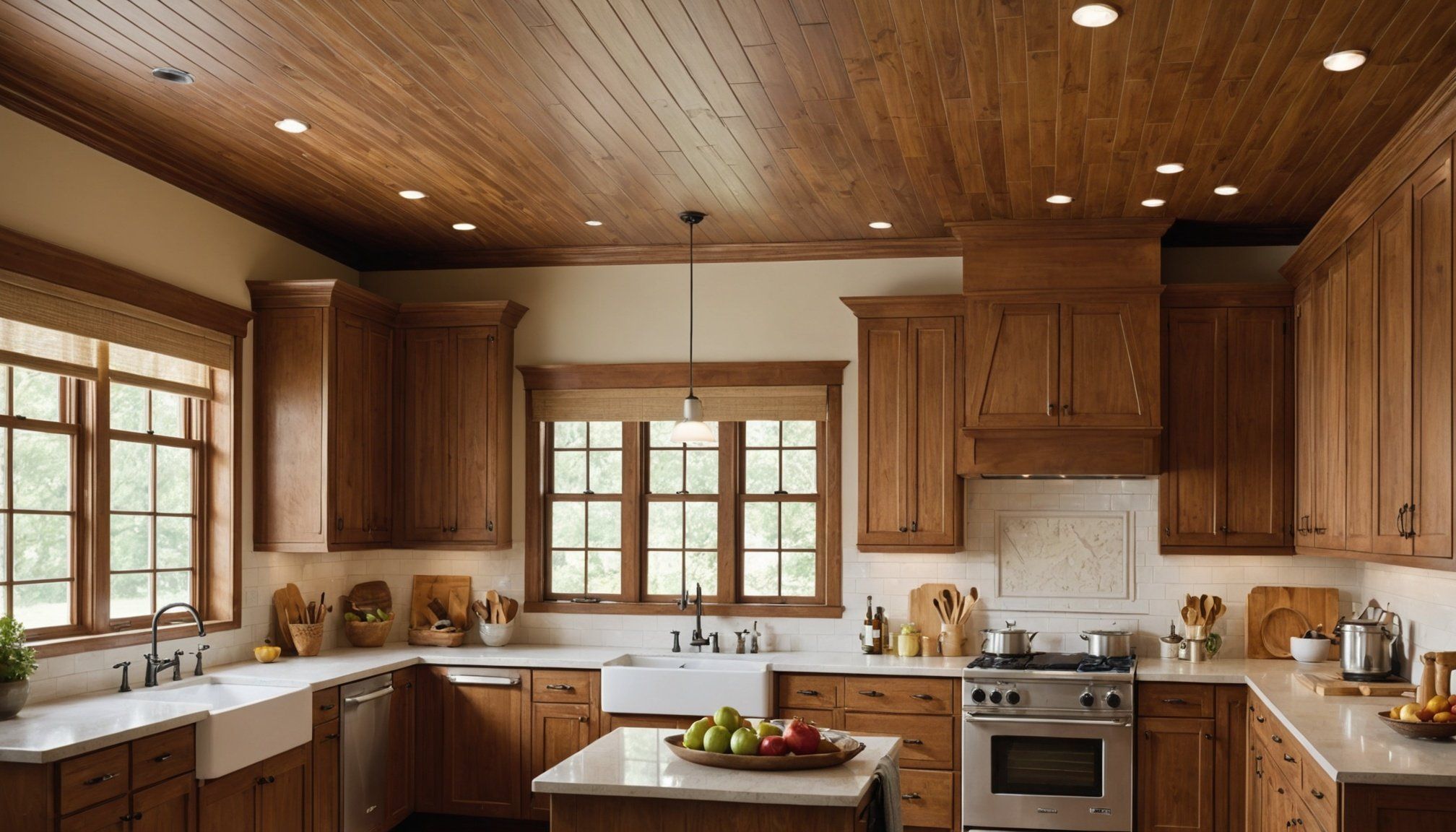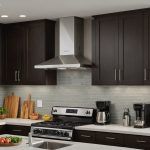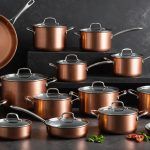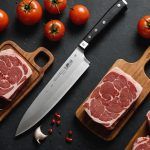Overview of Kitchen Ceiling Materials
Choosing the right kitchen ceiling materials is crucial for blending aesthetics with functionality in your cooking space. The kitchen is a high-activity zone, subject to heat, humidity, and the occasional cooking spatter, making the choice of ceiling material pivotal. Dust-resistant ceilings add convenience to kitchen maintenance, reducing the need for frequent cleaning.
Common kitchen ceiling materials include drywall, PVC tiles, metal panels, and wood planks. Drywall offers a smooth finish and versatility in design but might struggle with moisture. PVC tiles are celebrated for their resistance to dust and grime and easy maintenance. Metal panels add a sleek, modern look, lending themselves well to minimalist designs. Wood planks introduce warmth and character but demand more effort in maintenance to manage dust and moisture.
Also to discover : Create an allergen-free kitchen paradise with a centralized vacuum system for a spotless home
Balancing aesthetics and functionality helps to create an environment that’s both visually appealing and efficient in kitchen ceiling material selection. Opting for materials that are not only aligned with the design but are also durable and easy to clean, ensures that the kitchen remains both spectacular and practical. Aesthetics should not compromise functionality, especially in a space as dynamic as the kitchen.
Top Kitchen Ceiling Materials
When it comes to selecting the best materials for kitchen ceilings, a balance between durability and aesthetics is essential. Various options offer unique benefits and challenges.
Also read : Seamless Access: Cutting-Edge Overhead Cabinets for Your Smart, Health-Conscious Kitchen
Drywall
Drywall is a popular choice due to its versatility and smooth finish. It’s cost-effective but not the most durable ceiling option for high-moisture environments. Its maintenance involves regular painting to protect against moisture and mould. However, its ability to be shaped and painted makes it desirable for homeowners seeking a specific aesthetic.
PVC Tiles
PVC tiles stand out for their easy-to-clean properties. They’re resistant to dust and grime, making maintenance a breeze. The installation process is straightforward, often making them a budget-friendly ceiling choice. However, the initial cost can be higher than other materials.
Metal Panels
Metal panels add a modern touch and are extremely durable. They reflect light effectively, enhancing kitchen brightness. Cleaning requires minimal effort, needing only a wipe with a soft cloth. They are an excellent choice for a sleek, contemporary look.
Wood Planks
Wood planks bring warmth and character into the kitchen. They require more maintenance due to dust accumulation, needing regular cleaning and treatment to prevent damage. Special wood treatments can simplify cleaning and help maintain their natural aesthetic.
Factors to Consider When Choosing Kitchen Ceiling Materials
Selecting the right ceiling materials for a kitchen renovation entails combining functionality with personal preferences and budget-friendly ceilings. First, examine your kitchen layout. Ceiling height and size influence material selection, impacting both aesthetics and practicality. A lower ceiling might benefit from reflective surfaces like metal panels to enhance space perception.
Budgetary considerations play a significant role. While some durable ceiling options like metal panels may be costlier upfront, their longevity could offer long-term savings. Conversely, cheaper materials like drywall may necessitate more frequent maintenance, affecting overall cost-efficiency.
Durability is another critical factor. Kitchens frequently experience changes in temperature and humidity, necessitating moisture-resistant materials. Kitchen renovation considerations should also account for lifestyle and usage. A bustling family kitchen might prioritize materials that withstand wear and tear, while a showplace kitchen might favour aesthetics.
Finally, consider how the ceiling ties into the overall kitchen aesthetic. It’s vital to choose materials that complement your kitchen’s style, whether it’s rustic wood planks or sleek PVC tiles, ensuring your choosing ceiling materials process results in a harmonious and appealing kitchen environment. Balancing these factors aids in making informed decisions that cater to both function and form.
Practical Tips for Installation and Maintenance
When contemplating kitchen ceiling projects, considering whether to engage a professional or pursue a DIY approach is crucial. Professional installation ensures expertise and precision, reducing the margin for error. However, DIY ceiling projects can be more economical and rewarding if you’re equipped with the right tools and knowledge.
For successful DIY ceiling installation, beginning with essential tools is key. You’ll need measuring equipment, ladders, cutting tools, and proper safety gear. Materials like screws, drill bits, and protective sheets are also necessary to ensure smooth execution and prevent damage to your kitchen ceiling.
Regular kitchen ceiling maintenance can significantly prolong the lifespan of your chosen material. Dust accumulation is a common issue, especially with wood planks, necessitating frequent dusting and occasional polishing. Easy-to-clean ceilings such as PVC tiles demand minimal maintenance, requiring only occasional wiping to maintain their shine.
Furthermore, for materials prone to moisture like drywall, applying sealants or paints can add a protective layer, reducing the risk of damage. Consistent checks for cracks or discolorations can preempt serious issues, making maintenance an integral component of long-term kitchen care. Adherence to these practices ensures your kitchen ceiling remains pristine and functional.
Comparison of Kitchen Ceiling Options
Understanding how various materials compare can help make informed choices when it comes to ceiling installations. This section contrasts these options in terms of ceiling material comparison, focusing on durability, maintenance, and aesthetic appeal vs functionality.
Durability Comparison
Selecting a ceiling material impacts its longevity. Metal panels are noted for their exceptional durability and resistance to environmental wear. PVC tiles, though slightly less robust, are resilient against moisture. Wood planks, despite being appealing, require more care to ensure longevity in humid environments. Thus, frequent kitchen use might necessitate prioritising durability over purely aesthetic qualities.
Maintenance Needs
In terms of maintenance, easy-to-clean ceilings like PVC tiles hold an advantage due to their resistance to dust and grime. Metal panels also demand minimal upkeep, usually just a simple wipe. Conversely, wood planks need consistent dusting and occasional treatments to retain their look without accumulating dust over time. Taking proactive measures reduces the long-term maintenance burden.
Aesthetic Versatility
For aesthetic appeal vs functionality, wood planks are unmatched in providing warmth and character, appealing to rustic tastes. Metal panels fit a contemporary, minimalist approach, while PVC tiles offer a modern look with the convenience of easy maintenance. Ultimately, the choice should harmonise with the overall kitchen aesthetic, ensuring the ceiling material complements other design elements.











